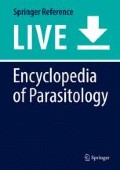Keywords
These keywords were added by machine and not by the authors. This process is experimental and the keywords may be updated as the learning algorithm improves.
Classification
Species of Monogenea.
Life Cycle
Figure 1.
Life cycle of Polystomum integerrimum. 1 Adult fluke inside urinary bladder/cloaca; when frogs become mature, flukes also reach maturity (apparently stimulated by the sexual hormones of the host). 2–5 Operculated eggs are set free with feces; in water each egg develops a larva with hooks (oncomiracidium) which leaves the egg and may initiate two different developmental cycles (6–9 or 10, 11). 6–9 When the oncomiracidia become attached to tadpoles with outer gills (6; arrow), they grow into gill (or branchial) flukes (7) which are thought to represent neotenic forms. These branchial flukes produce a few eggs (8) which give rise to new oncomiracidia (9). 10, 11 When the oncomiracidium enters inner gills of tadpoles by way of spiracle (10; arrow), the development to the final bladder generation is initiated. When the tadpole undergoes metamorphosis, the worm passes out of the branchial chamber, migrates down the host’s intestine, and may become established in the host’s bladder where it reaches sexual maturity within 3 years (in the frog). CI cilia, ES eye spot, EX excretory pore, GP genital pore (uterus + vas deferens of testis), HK hooks, IN intestine, OH opisthaptor (caudal disk), OV ovary, P pharynx, PH prohaptor (mouth), PR protonephridia, SU sucker, TE multilobed testis with sperms, VG vagina
Author information
Authors and Affiliations
Corresponding author
Editor information
Editors and Affiliations
Rights and permissions
Copyright information
© 2015 Springer-Verlag Berlin Heidelberg
About this entry
Cite this entry
Mehlhorn, H. (2015). Polystomum Integerrimum. In: Mehlhorn, H. (eds) Encyclopedia of Parasitology. Springer, Berlin, Heidelberg. https://doi.org/10.1007/978-3-642-27769-6_2489-2
Download citation
DOI: https://doi.org/10.1007/978-3-642-27769-6_2489-2
Received:
Accepted:
Published:
Publisher Name: Springer, Berlin, Heidelberg
Online ISBN: 978-3-642-27769-6
eBook Packages: Springer Reference Biomedicine and Life SciencesReference Module Biomedical and Life Sciences


